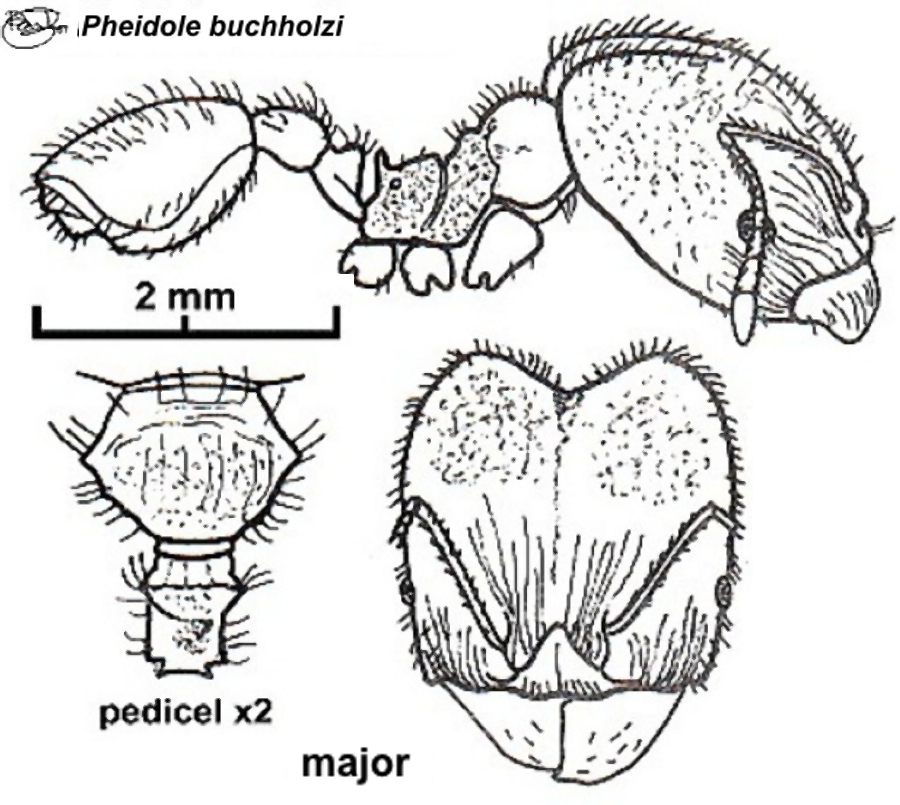Pheidole buchholzi Mayr
  Type location Cameroun (Pheidole Buchholzi nov. spec.,
Mayr, 1901a: 276, major & minor - see below; Santschi, 1914d: 336,
queen [not
in Bolton, 1995]; Forel, 1916: 413, queen) collected at Mungo River by
R. Buchholz, Oct. 1874; major, minor and queen described (see Bolton,
1995) Type location Cameroun (Pheidole Buchholzi nov. spec.,
Mayr, 1901a: 276, major & minor - see below; Santschi, 1914d: 336,
queen [not
in Bolton, 1995]; Forel, 1916: 413, queen) collected at Mungo River by
R. Buchholz, Oct. 1874; major, minor and queen described (see Bolton,
1995)  . .
|
Mayr's (1901a) description of the major is at  and of the minor is at and of the minor is at  . Santschi's (1914d) description of the
queen is at . Santschi's (1914d) description of the
queen is at 
Wheeler (1922) had other Cameroun records from
Victoria (F. Silvestri) and an unknown location (L. von Muralt); also
from Zaïre. Santschi (1935) also saw 1 major and 8 minors from
Mongede, Zaïre.
Bernard (1952) recorded it from the Mt. Nimba, Guinea,
surveys; several minors from station B8-10, 1250 m; also from Yanlé,
Nion 700 m, forest at 1000-1200 m, crest at 1300 m.
|
 Nigeria
specimens (Taylor, 1980a: 17, as Pheidole
speculifera). Nigeria
specimens (Taylor, 1980a: 17, as Pheidole
speculifera).
MAJOR - TL 6.97 mm, HL 2.27, HW 2.33, SL 1.18, PW 1.00
Dark orange-brown. Head rugose anteriorly and reticulopunctate on the
dorsum. Mesonotum and propodeum spiculate. Erect hairs coarse and
abundant. Head with short frontal carinae, the clypeus slightly
emarginate and with a slight medial carina. Propodeal spines relatively
stout, blunt and curved laterally. Petiole emarginate with paired
obtuse teeth dorsolaterally. Postpetiole shorter and broader than that
of minor.
Wheeler (1922) included it from Cameroun
(Johann-Albrechtschöhe, Conradt), plus very wide sub-Saharan
localities. He noted his specimens, four majors from Faradje, and five
workers from Garamba (in the stomach of a frog) matched Emery's
description of the types from Abyssinia, but the minors were darker;
the major size was no more than 6 mm whereas cubangensis was
described by Forel as being TL 7 mm, with whole head opaque; Wheeler's
specimens had the smooth shining areas of the vertex shown in his
illustrations (right).
Bernard (1952) noted it as inhabiting all of tropical
Africa, but probably originating in montane areas, from where come the
principal varieties. In Guinea it was very common around Mt.
Nimba, with colonies on the crests at 1600 m. As was frequent with the
systematics of Santschi, Bernard found minors and majors from one
locality appearing to come from different races. Majors (4 from Nion)
tended to have the rounded matt head typical of the variety bisperula
(a mis-spelling of bispecula). Minors on the other hand
appeared most like the variety ascarus from Eritrea, being
blacker, shinier and with a more slender petiole. He also described the
previously unknown queen.
Nigeria it nests in dead wood and soil in
crevices on living trees. Rare but found foraging on the ground and
tending aphids on cocoa, e.g. at Onipe 1/1.
In Ghana, specimens determined as this were
found in dead wood on the ground under cocoa, and as Pheidole near
speculifera foraging in cocoa leaf litter at the
Mamfe-Mampong farm in Ghana by Room (1971); also on cocoa mistletoe
(Room, 1975); and on cocoa at Kade by Majer (1975, 1976 b), using pkd,
and finding two workers in a single sample. Two workers were found on
the ground under Amelonado cocoa at CRIG (Bigger, 1981a).
Relatively abundant in shaded areas of one cocoa plot at
Nko'emvon in Cameroun, where Jackson (1984) collected it in
pitfall traps. Weakly negatively associated with Pheidole species
2 in the same plot.
|
 Nigeria
specimens (Taylor, 1980a: 17). Nigeria
specimens (Taylor, 1980a: 17).
MINOR - TL 3.42 mm, HL 0.86, HW 0.65, SL 1.17, PW 0.47
Yellow-orange, shiny, with a transparent cuticle. Sculpturation only of
spiculation on the propodeum, lateral mesonotum and the petiole.
Petiole with a low node flattened dorsally in profile; postpetiole with
a domed profile and ovoid in dorsal view.
|